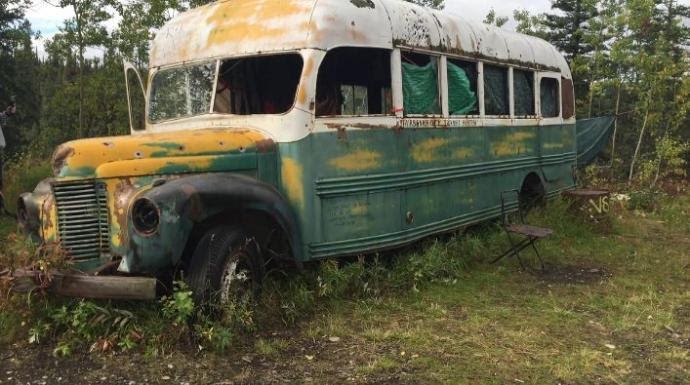In a joint operation organized by the Alaska Army National Guard and the state’s Department of National Resources, the famous “Magic Bus” has been airlifted out of stampede trail in the Denali Borough, Alaska [1]. Following its adaptation into a non-fiction book and the 2007 movie Into the Wild, the abandoned vehicle became an object of global interest and travel fantasy. It was moved from its age-long site at a grassy spot west of the Teklanika River near Healy. The extraction occurred on Monday, June 15, nearly 28 years after the death of adventurer Chris McCandless, who lived in the abandoned vehicle for 114 days [2].
Formally identified as Bus 142, the 1940s-era Fairbanks vehicle has been depicted as a “perilous tourist attraction”. The bus was initially used by hunters who knew the area well and sought temporary shelter, until McCandless’s stakeout in 1992.
Thousands of hikers from all over the world have visited Stampede Trail since the Hollywood adaptation hit the screens, with so many aiming to retrace the steps of 24-year-old McCandless who is reported to have died of starvation. According to the Department of Natural Resources, many of the travelers have come to serious harm in the course of their journeys. The site had become a sort of pilgrimage ground for dedicated hikers trying to recreate McCandless’s adventure. Dozens of people have been hurt in the dangerous Alaskan wilderness, and at least two hikers have lost their lives in the process [3].
“After studying the issue closely, weighing many factors and considering a variety of alternatives, we decided it was best to remove the bus from its location on the Stampede Trail,” said Commissioner for the Department of Natural Resources, Corri A. Feige, in a press release. “We’re fortunate the Alaska Army National Guard could do the job as a training mission to practice airlifting vehicles, at no cost to the public or additional cost to the state.”
Read: The Woman Who Lives 200,000 Years in the Past
A permanent location is still being considered

According to Commissioner Fidge, the bus will remain in storage while the parties involved decide what to do with it. It would most likely be carted off to a safer location where it would be set up for display. A group of military personnel helicoptered into the site on Thursday afternoon for the extraction. Bus 142 was finally removed after soldiers drilled holes into its ceiling and floor to rig chains through it. It was airlifted by a twin-rotor Chinook helicopter.
The Department of Natural Resources had reached out to the AVN to facilitate the extraction and reduce the number of search and rescue cases resulting each year from the presence of the vehicle.
“We encourage people to enjoy Alaska’s wild areas safely, and we understand the hold this bus has had on the popular imagination,” Corri A. Feige, commissioner of the Alaska Department of Natural Resources, said in the release. “However, this is an abandoned and deteriorating vehicle that was requiring dangerous and costly rescue efforts, but more importantly, was costing some visitors their lives. I’m glad we found a safe, respectful, and economical solution to this situation.”
Read: Dick Proenneke: 30 Years Alone in the Alaskan Wilderness
From traveler to legend

Having sought an itinerant lifestyle for as long as he knew, Chris McCandless from Virginia gave away his college fund and traveled across America before arriving at Alaska in April 1992 [2]. With minimal supplies and a strong will to live off the grid, McCandless, who adopted the moniker “Alexander Supertramp” found Bus 142 at Stampede Trail and it became his home for the next four months. The last person who saw him alive was a local electrician named Jim Gallien. Before McCandless found the bus, he’d been accosted by Gallien at the head of the trail where the man worried about his safety and offered to help him get more supplies. McCandless declined his offer and delved deep into the bush before he found the abandoned vehicle.
His story was told from the journal entries he made throughout his days in the bus. His last note had read: “I HAVE HAD A HAPPY LIFE AND THANK THE LORD. GOODBYE AND MAY GOD BLESS ALL!”
McCandless was found by hunters almost three weeks after his death in September 1992, and according to autopsy reports, he was said to have died from starvation two weeks before his body was found. He had tried to exit the trail to continue his journey in July that year, but he was unable to re-cross the Teklanika River which had swollen with snowmelt.
His story was told in a 9,000-word article published in 1993 by Chris Krakauer titled “Death of an Innocent”. The article was later expanded and published as a non-fiction book in 1996 titled “Into the Wild”, a deeply touching story widely used as a high school and college reading material. The story was later made into a film in 2007. It has so far been nominated in 106 awards with 23 wins, including Academy Awards, Golden Globes, and the Gotham Independent Film Award for Best Feature.
You can watch the extraction video below:
Keep Reading: Alaska High School Teacher Hunted a Moose and had his Students Butcher the Animal to Learn Life Skills
- Adam Roy. Alaska Has Removed the “Into the Wild” Bus. Backpacker. https://www.backpacker.com/news-and-events/alaska-has-removed-the-into-the-wild-bus Retrieved 19-06-2020
- Robert Lewis. Christopher McCandless. Britannica. https://www.britannica.com/biography/Christopher-McCandless Retrieved 19-06-2020
- Adam Roy. ‘Into The Wild’ Bus Claims Another Life. Backpacker. https://www.backpacker.com/news-and-events/into-the-wild-bus-death Retrieved 19-06-2020
- Alaska National Guard. Facebook. https://web.facebook.com/AlaskaNationalGuard/posts/10157393705831238?_rdc=1&_rdr Retrieved 19-06-2020
- https://dnr.alaska.gov/
- Death of an Innocent: Jon Krakauer’s Into the Wild. Book Marks. https://bookmarks.reviews/death-of-an-innocent-jon-krakauers-into-the-wild/ Retrieved 19-06-2020

